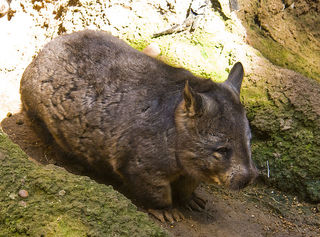
Original source: originally posted to Flickr as Southern Hairy-nosed Wombat
Author: Jason Pratt
Southern hairy-nosed wombat
Order : Diprotodontia
Family : Vombatidae
Species : Lasiorhinus latifrons
The Southern hairy-nosed wombat is listed as Least Concern (LR/lc), lowest risk. Does not qualify for a more at risk category. Widespread and abundant taxa are included in this category, on the IUCN Red List of Threatened Species
Namings for the southern hairynosed wombat
A young / baby of a southern hairynosed wombat is called a 'joey'. The females are called 'jill' and males 'jack'. A southern hairynosed wombat group is called a 'mob, warren, wisdom or army'.Countries
AustraliaSome facts about the
Hairy-nosed wombat
Adult weight : 25.5 kg (56.1 lbs)
Maximum longevity : 30 years
Female maturity :547 days
Male maturity : 547 days
Gestation : 21 days
Weaning : 312 days
Litter size : 1
Interval between litters : 365 days
Weight at birth : 0.001 kg (0.0022 lbs)
Weight at weaning : 3.633 kg (7.9926 lbs)
Basal metabolic rate : 16 W
Body mass : 27.348 kg (60.1656 lbs)
Temperature : 34.85 °C (94.73 °F)
Facts about the southern hairy-nosed wombat
Lasiorhinus latifrons is now found in only a few areas of South Australia, including the Gawler Ranges, the southern portion of the Nullabor, and west of Penong.
Research in the School of Biological Sciences Honours Projects for Prospective Students Laboratories and Researchers Monash University > Labs > Taylor > Wombat > Research The southern hairy-nosed wombat, Lasiorhinus latifrons, is a large, burrowing marsupial of South Australia (map).
In view of 3, 4 & 5 above the Scientific Committee is of the opinion that the Southern Hairy-nosed Wombat Lasiorhinus latifrons is likely to become extinct in nature in NSW unless the circumstances and factors threatening it survival cease to operate.
The Southern hairy-nosed wombat, Lasiorhinus latifrons, is the smallest wombat species.
The Southern Hairy-nosed Wombat (Lasiorhinus latifrons) is found in scattered areas of semi-arid scrub and mallee from the eastern Nullarbor Plain to the New South Wales border area. (Full text)
The Southern Hairy-nosed Wombat (Lasiorhinus latifrons) is found in scattered areas of semi-arid scrub and mallee from the eastern Nullarbor Plain to the New South Wales border area.
The Southern Hairy-nosed Wombat (Lasiorhinus latifrons) is found in scattered areas of semi-arid scrub and mallee from the eastern Nullarbor Plain to the New South Wales border area. (Wiki)
The Southern Hairy-nosed Wombat (Lasiorhinus latifrons) is found in scattered areas of semi-arid scrub and mallee from the eastern Nullarbor Plain to the New South Wales border area. (Full text)
The Southern Hairy-nosed Wombat (Lasiorhinus latifrons) is found in scattered areas of semi-arid scrub and mallee from the eastern Nullarbor Plain to the New South Wales border area. (Full text)
The Southern Hairy-nosed Wombat ( Lasiorhinus latifrons) is found in scattered areas of semi-arid scrub and
As with all wombats, the Southern Hairy-nosed Wombat is a marsupial.
The Southern Hairy-nosed Wombat is a communal species with extensive burrow systems inhabited by five to ten animals of both sexes.
The southern hairy-nosed wombat is less common and is found on the Nullarbor Plain in Western Australia and in several areas of South Australia.
adult Southern Hairy-nosed wombat is approximately 10-20% smaller than an adult Common wombat. (Full text)
The southern hairy-nosed wombat is found only on the Nullarbor Plain in South Australia, and the northern hairy-nosed wombat is found only in a small area of Queensland. (Full text)
Pouch young cross fostering (removing a pouch young from a Northern Hairy-nosed wombat and allowing it to be raised by a female Southern Hairy-nosed Wombat) is being investigated to increase reproductive output. (Full text)
Scientific name: Lasiorhinus latifrons The southern hairy-nosed wombat is the smallest of the three types of wombat.
The southern hairy-nosed wombat is protected under the National Parks and Wildlife Act, 1972.
Habitat Southern Hairy-nosed Wombats are found in southern South Australia from the western side of the Murray River from Swanreach to Morgan, the southern border of the Nullarbor Plain to the east of Eucla and some small colonies in the Gawler Ranges, on the Eyre and York Peninsulas.
Southern Hairy-nosed Wombats are similar in size to Common Wombats, but have softer, silkier, grey fur, longer ears and fine fur on their much broader nose.
Southern hairy-nosed wombats are the most arid-adapted wombat species, occurring across the hot, dry Nullabor Plains of southern Australia.
Southern hairy-nosed wombats are very rare, and until recently were thought to be extinct in NSW. (Full text)
Southern hairy-nosed wombats are endangered. (Full text)
"If we can find out how southern hairy-nosed wombats are repsonding behaviourally to isolation, then we will have a better idea of how to manage their northern counterparts.
Southern Hairy-nosed Wombats are found in southern South Australia from the western side of the Murray River from Swanreach to Morgan, the southern border of the Nullarbor Plain to the east of Eucla and some small colonies in the Gawler Ranges, on the Eyre and York Peninsulas.
Southern Hairy-nosed Wombats are similar in size to
More animals beginning with S
